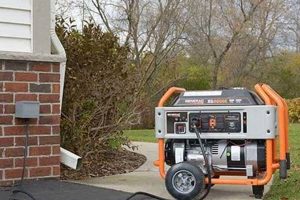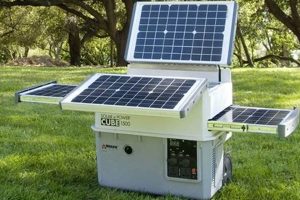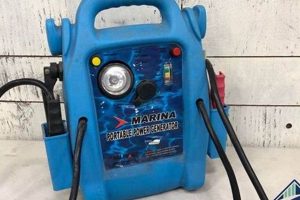Supplying residential power using a compact, mobile electricity source offers a temporary solution during utility outages or in off-grid locations. This approach involves connecting the generator to a home’s electrical system, often through a transfer switch, to power essential circuits or appliances. For example, a homeowner might employ this strategy during a severe storm that disrupts the power grid.
Maintaining electrical service during emergencies ensures the functionality of critical systems like heating, refrigeration, and medical devices. It offers a degree of independence from the main power grid, providing stability and continuity in unforeseen circumstances. Historically, reliance on these alternative power sources emerged as a practical response to the vulnerability of centralized power distribution systems, particularly in disaster-prone areas or remote settings.
Further exploration will address the practicalities of generator selection, safe operation, connection procedures, and legal considerations involved in utilizing this backup power strategy.
Tips for Utilizing Portable Generators for Home Power
Effective and safe use of portable generators requires careful planning and adherence to safety guidelines. These tips offer practical advice for homeowners considering this backup power solution.
Tip 1: Accurate Power Assessment: Determine the wattage requirements of essential appliances and circuits. Sum these wattages to select a generator with sufficient capacity. Running a generator beyond its rated capacity can lead to damage.
Tip 2: Professional Installation of a Transfer Switch: Direct connection to household circuits is unsafe and can backfeed into the power grid, endangering utility workers. A properly installed transfer switch isolates the home’s electrical system from the grid during generator operation.
Tip 3: Adherence to Local Regulations: Consult local ordinances and permitting requirements related to generator installation and usage. Some jurisdictions may have noise restrictions or require specific permits.
Tip 4: Generator Placement: Operate generators outdoors in a well-ventilated area, away from doors, windows, and air intakes. Exhaust fumes contain carbon monoxide, a colorless, odorless, and deadly gas.
Tip 5: Proper Fuel Handling: Store fuel in approved containers in a safe location. Allow the generator to cool completely before refueling to prevent fire hazards.
Tip 6: Regular Maintenance: Follow the manufacturer’s recommendations for maintenance, including oil changes and air filter cleaning. Regular maintenance ensures reliable operation and prolongs the generator’s lifespan.
Tip 7: Carbon Monoxide Detectors: Install functioning carbon monoxide detectors near sleeping areas. These detectors provide an early warning of potentially lethal carbon monoxide buildup.
Tip 8: Dry Operation Prevention: Never operate a generator without sufficient oil. Running a generator dry can cause severe engine damage.
Careful planning and safe operation are crucial for maximizing the benefits of portable generators while minimizing risks. Adherence to these guidelines ensures a reliable and safe power supply during emergencies.
These considerations offer a practical foundation for effectively employing a portable generator as a backup power source. The following section will conclude with final recommendations and additional resources.
1. Generator Sizing
Determining the appropriately sized generator is paramount when considering powering a house with a portable unit. Incorrect sizing can lead to insufficient power for essential needs or generator overload, resulting in damage and potential safety hazards. Careful calculation of power requirements is essential for successful implementation.
- Running Watts vs. Starting Watts
Appliances require a surge of power upon startup (starting watts), significantly higher than the power needed for continuous operation (running watts). For example, a refrigerator might require 1,200 starting watts but only 200 running watts. Generator sizing must account for the highest starting wattage of any appliance intended for simultaneous use, in addition to the sum of running wattages. Overlooking this difference can lead to tripped breakers or generator failure.
- Load Prioritization
Prioritizing essential appliances allows for more efficient generator use. Critical devices like refrigerators, medical equipment, or sump pumps should be prioritized during outages. Less essential items like entertainment systems or electric ovens can be excluded to minimize power demands. This tiered approach optimizes generator capacity and extends fuel life.
- Wattage Calculation
Accurately determining total wattage needs involves adding the running watts of each intended appliance. Consulting appliance manuals or checking wattage labels provides this information. Online wattage calculators can also assist. Overestimating wattage provides a safety margin, while underestimating risks overloading the generator. A detailed wattage assessment is critical for selecting an appropriately sized generator.
- Generator Capacity Options
Generators are available in various sizes, typically ranging from a few thousand watts for smaller portable units to tens of thousands of watts for larger models. Choosing the correct size balances power needs with portability and cost. Smaller generators are more portable but may not power entire homes. Larger generators offer more capacity but are less portable and more expensive. Careful consideration of these factors is crucial for an informed decision.
Accurate generator sizing directly impacts the feasibility and effectiveness of powering a home with a portable generator. Understanding wattage demands, prioritizing loads, and selecting a generator with adequate capacity are essential for ensuring a reliable backup power solution.
2. Transfer Switch
Transfer switches play a crucial role in safely powering a house with a portable generator. They serve as an intermediary between the generator, the house’s electrical system, and the utility grid, preventing dangerous backfeeding. Backfeeding occurs when electricity from the generator flows back into the power lines, posing a significant electrocution risk to utility workers and potentially damaging grid equipment. Without a transfer switch, attempting to power a home with a portable generator creates this substantial hazard. A properly installed transfer switch isolates the home’s circuits from the utility grid when the generator is in use, ensuring safety. For example, during a power outage, a homeowner activates the transfer switch, effectively disconnecting the house from the utility power lines and allowing the generator to safely power selected circuits.
Transfer switches come in two main types: manual and automatic. Manual transfer switches require the homeowner to physically move a lever or flip a switch to change the power source. Automatic transfer switches detect a power outage and automatically switch to the generator, providing a seamless transition to backup power. Selecting the appropriate transfer switch depends on individual needs and budget. A qualified electrician should install the transfer switch to ensure proper integration with the home’s electrical system and compliance with local electrical codes. For instance, a homeowner with critical medical equipment might opt for an automatic transfer switch for uninterrupted power during an outage, while a homeowner with less critical backup power needs might choose a manual transfer switch for its lower cost.
Safe and effective generator use necessitates the inclusion of a transfer switch. This component not only protects utility workers and equipment but also safeguards the home’s electrical system. Understanding the function and importance of a transfer switch underscores the critical role it plays in successfully and safely powering a home with a portable generator. Failure to utilize a transfer switch presents significant risks and compromises the practicality of this backup power strategy.
3. Fuel Supply
Fuel supply is a critical aspect of using a portable generator for home power. Generator runtime directly depends on fuel availability and efficient management. Without sufficient fuel, the generator cannot provide the necessary power, rendering it ineffective during outages. Understanding fuel types, storage, and consumption rates is essential for successful generator operation.
- Fuel Type
Portable generators typically use gasoline, propane, or diesel. Gasoline is common but has a limited shelf life. Propane offers longer storage stability but requires larger tanks. Diesel provides high efficiency but can gel in cold temperatures. Fuel choice impacts generator performance, maintenance, and storage requirements. Selecting the appropriate fuel type depends on individual needs and environmental conditions. For example, a homeowner in a cold climate might prefer propane for its resistance to gelling, while someone prioritizing fuel economy might choose diesel.
- Storage Capacity and Safety
Safe fuel storage is paramount for both generator operation and household safety. Fuel should be stored in approved containers, away from ignition sources and in well-ventilated areas. Properly labeled containers prevent accidental misuse. Rotating fuel stock ensures freshness, particularly for gasoline, which degrades over time. For instance, storing gasoline in a clearly marked, approved container in a detached shed reduces fire hazards and maintains fuel quality.
- Consumption Rate and Runtime
Generators consume fuel at varying rates depending on load and capacity. Larger loads increase fuel consumption, reducing runtime. Manufacturers provide estimated runtime information based on load and fuel capacity. Calculating estimated runtime based on anticipated load helps determine necessary fuel reserves. A homeowner powering essential appliances during an outage can estimate fuel needs based on the generator’s consumption rate and the expected duration of the outage.
- Refueling Procedures
Safe refueling procedures are critical for preventing fires and accidents. Always allow the generator to cool completely before refueling. Avoid spilling fuel and ensure the area is well-ventilated. Grounding the generator and fuel container prevents static electricity buildup. Refueling outdoors minimizes fire risks. For instance, waiting for the generator to cool down before refueling on a level surface outdoors, away from flammable materials, minimizes hazards.
Adequate fuel supply directly impacts the practicality of using a portable generator for home backup power. Understanding fuel options, storage, consumption, and safe handling procedures is crucial for successful implementation. Failing to address these considerations can lead to insufficient power during outages and compromise safety. Fuel management is an integral component of a comprehensive backup power strategy.
4. Safety Procedures
Safe operation is paramount when utilizing a portable generator for residential power. Negligence in following safety protocols can lead to severe consequences, including carbon monoxide poisoning, fire hazards, and electrocution. Understanding and implementing appropriate safety measures is crucial for protecting life and property.
- Ventilation
Generator exhaust contains carbon monoxide, an odorless, colorless, and lethal gas. Operating a generator in enclosed spaces or near open windows, doors, or vents can lead to carbon monoxide buildup within the home. Adequate ventilation is essential to prevent fatal exposure. Positioning the generator outdoors, far from any dwelling openings, ensures safe exhaust dispersal.
- Electrical Connections
Improper electrical connections can result in electrocution and fires. Directly connecting a generator to household circuits without a properly installed transfer switch can cause backfeeding, energizing power lines and posing a lethal threat to utility workers. Utilizing a transfer switch isolates the home’s electrical system from the grid during generator operation, ensuring safe power delivery.
- Fuel Handling
Gasoline and other fuels are highly flammable. Spilled fuel near a hot generator can ignite, causing fires and explosions. Allowing the generator to cool completely before refueling minimizes this risk. Storing fuel in approved containers, away from ignition sources, further reduces fire hazards. Proper grounding during refueling prevents static electricity discharge, another potential ignition source.
- Dry Operation
Operating a generator without sufficient oil can cause severe engine damage. Regularly checking and maintaining proper oil levels is crucial for preventing dry operation and ensuring smooth generator function. Ignoring oil levels can lead to costly repairs or complete engine failure, rendering the generator unusable during power outages.
Adherence to safety procedures is non-negotiable when powering a house with a portable generator. Overlooking these precautions risks serious injury or death. Prioritizing safety through proper ventilation, electrical connections, fuel handling, and maintenance ensures responsible generator use and mitigates potential hazards, ultimately safeguarding individuals and property.
5. Maintenance Requirements
Regular maintenance is essential for reliable and safe operation of a portable generator used for residential power. Neglecting routine maintenance can lead to decreased performance, premature failure, and potential safety hazards during critical power outages. A well-maintained generator ensures consistent power delivery when needed most, while a poorly maintained unit can become a liability.
- Oil Changes
Regular oil changes are crucial for lubricating engine components and preventing excessive wear. Engine oil degrades over time and loses its lubricating properties. Following manufacturer recommendations for oil change intervals, typically based on operating hours, ensures optimal engine performance and longevity. For example, failing to change the oil can lead to increased friction, overheating, and ultimately engine damage, rendering the generator unusable.
- Air Filter Cleaning/Replacement
Clean air filters are essential for proper engine combustion. Dirty air filters restrict airflow, reducing engine efficiency and potentially causing damage. Regularly cleaning or replacing air filters, according to manufacturer guidelines or as needed based on operating conditions, ensures optimal air intake and efficient fuel combustion. A clogged air filter can lead to reduced power output, increased fuel consumption, and potential engine overheating.
- Spark Plug Inspection/Replacement
Spark plugs ignite the fuel-air mixture in the engine cylinder. Worn or fouled spark plugs can cause misfires, reducing engine performance and potentially damaging the engine. Periodic inspection and replacement of spark plugs, as recommended by the manufacturer, ensure reliable ignition and efficient fuel combustion. Ignoring worn spark plugs can lead to rough running, difficulty starting, and decreased power output.
- Fuel System Maintenance
Maintaining the fuel system prevents fuel degradation and ensures reliable starting and operation. Draining old fuel or using fuel stabilizers prevents gum and varnish buildup in the carburetor and fuel lines. Inspecting and cleaning fuel lines and filters prevents blockages and ensures consistent fuel delivery. Neglecting fuel system maintenance can lead to starting difficulties, rough running, and reduced generator lifespan.
Adhering to a regular maintenance schedule is crucial for maximizing the lifespan and reliability of a portable generator used for home power. Consistent maintenance minimizes the risk of unexpected failures during power outages, ensuring a dependable source of electricity when needed. Ignoring maintenance requirements compromises the generator’s performance and safety, potentially leaving a household without power during critical situations. Regular maintenance is an investment in the generator’s long-term functionality and the homeowner’s peace of mind.
6. Local Regulations
Regulations established by local authorities play a significant role in the feasibility and legality of using portable generators for residential power. These ordinances address various aspects, from permitting requirements and noise restrictions to safety standards and installation guidelines. Compliance with local regulations is not only essential for legal operation but also for community safety and harmonious coexistence. Ignoring these regulations can result in fines, operational restrictions, or even legal action.
- Permitting Requirements
Many jurisdictions require permits for installing and operating portable generators, particularly for permanent or semi-permanent installations. Permitting processes often involve inspections to ensure compliance with safety and installation codes. Failure to obtain necessary permits can result in fines and enforced generator removal. For instance, a homeowner intending to connect a generator to a transfer switch might require a permit and inspection to ensure electrical safety and code compliance.
- Noise Restrictions
Noise ordinances aim to minimize noise pollution from generator operation. These regulations often specify permissible noise levels and allowable operating hours. Exceeding these limits can result in citations and restrictions on generator usage. Homeowners in densely populated areas might need to consider quieter generator models or sound-dampening enclosures to comply with local noise regulations. For example, some communities restrict generator operation during nighttime hours to minimize disturbance to neighbors.
- Safety Standards and Installation Codes
Local codes dictate specific safety requirements for generator installation and operation. These codes address aspects such as proper grounding, ventilation, fuel storage, and connection procedures. Adherence to these standards ensures safe operation and minimizes risks associated with carbon monoxide poisoning, fire hazards, and electrocution. For instance, local codes might mandate specific clearances around generators for proper ventilation and prevent the buildup of hazardous exhaust fumes.
- Emergency Management Plans
Some localities incorporate generator usage into emergency management plans, particularly in disaster-prone areas. These plans might outline guidelines for generator operation during emergencies, including fuel distribution and prioritized usage for essential services. Understanding local emergency plans and coordinating with relevant authorities during emergencies ensures efficient resource management and community safety. For example, a community might designate specific locations for generator refueling during widespread power outages.
Local regulations significantly influence the use of portable generators for residential power. Understanding and complying with these regulations is not merely a legal obligation but a crucial aspect of responsible generator ownership. Compliance ensures both the safety of the homeowner and the surrounding community while facilitating effective backup power solutions. Ignoring local regulations can not only lead to legal repercussions but also compromise the practicality and effectiveness of using a portable generator during power outages.
7. Power Prioritization
Power prioritization is intrinsically linked to the feasibility of using a portable generator for whole-house power. Generators possess finite power output capabilities. Matching available wattage to essential circuits and appliances ensures effective power distribution during outages. Without prioritization, a generator might be overloaded, leading to tripped breakers or generator shutdown, leaving critical systems without power. For example, a homeowner with a 5,000-watt generator might prioritize powering a refrigerator, a furnace blower, and a few essential lights, leaving non-essential appliances like a clothes dryer or entertainment system offline during an outage. This prioritization ensures sufficient power for critical needs without exceeding the generator’s capacity.
Effective power prioritization involves categorizing electrical loads based on necessity. Essential loads, such as those required for safety, health, and basic comfort, take precedence. These might include refrigerators, medical devices, well pumps, and sump pumps. Secondary loads, like lighting, communication devices, and computers, hold a lower priority. Non-essential loads, including entertainment systems, hot tubs, and electric ovens, are typically excluded from generator power during outages. This tiered approach maximizes the generator’s effectiveness by ensuring critical systems remain operational within the available power limits. For instance, during a prolonged outage, a homeowner might rotate secondary loads to conserve fuel and extend generator runtime, operating a washing machine only when other secondary loads are offline.
Successful implementation of a portable generator for whole-house power hinges on careful power prioritization. This process necessitates a clear understanding of household electrical needs and the generator’s power limitations. A prioritized approach prevents generator overload, maximizes runtime, and ensures critical systems remain functional during outages. Failing to prioritize power consumption can render a generator ineffective, compromising safety and comfort during power disruptions. A comprehensive power plan, incorporating prioritized load management, is essential for realizing the full potential of a portable generator as a reliable backup power source.
Frequently Asked Questions
This section addresses common inquiries regarding the use of portable generators for residential power, providing concise and informative responses to clarify potential uncertainties and misconceptions.
Question 1: Is a transfer switch necessary when using a portable generator?
A transfer switch is crucial for safe generator operation. It prevents backfeeding, protecting utility workers and preventing damage to the electrical grid. Direct connection without a transfer switch is unsafe and often illegal.
Question 2: What size generator is needed to power an entire house?
Generator sizing depends on the wattage requirements of the appliances and circuits one intends to power. Calculating total wattage and considering starting wattage requirements are essential for selecting an appropriately sized generator. Professional electricians can assist with accurate load assessments.
Question 3: Can a portable generator power a house indefinitely during an outage?
Runtime depends on the generator’s fuel capacity and the load. Continuous operation requires sufficient fuel reserves and adherence to manufacturer recommendations regarding runtime and load management. Fuel storage and refueling strategies are important considerations for extended outages.
Question 4: What are the safety considerations when operating a portable generator?
Operating generators outdoors in well-ventilated areas is crucial to prevent carbon monoxide poisoning. Proper fuel handling and storage are essential to minimize fire hazards. Electrical connections should be made through a transfer switch by a qualified electrician to prevent electrocution risks.
Question 5: How often should a portable generator be maintained?
Adhering to the manufacturer’s recommended maintenance schedule is essential for reliable operation. Regular oil changes, air filter cleaning/replacement, and spark plug inspection/replacement ensure optimal performance and prolong generator lifespan. Neglecting maintenance can lead to premature failure and safety hazards.
Question 6: Are there regulations regarding generator usage in residential areas?
Local ordinances often regulate generator usage, addressing noise levels, permitting requirements, and installation guidelines. Consulting local authorities ensures compliance with regulations and avoids potential fines or operational restrictions. Compliance promotes community safety and harmonious coexistence.
Careful consideration of these frequently asked questions provides a foundational understanding of the practicalities and safety considerations associated with using portable generators for residential power. Thorough planning and adherence to safety guidelines are crucial for responsible and effective generator operation.
For further information and personalized guidance, consulting with qualified electricians and local authorities is highly recommended. They can provide tailored advice based on specific needs and local regulations.
Powering a Home with a Portable Generator
The feasibility of using a portable generator for residential power depends on careful planning and execution. Key factors include accurate load assessment, proper generator sizing, safe installation of a transfer switch, adherence to safety protocols, diligent maintenance, compliance with local regulations, and effective power prioritization. Overlooking any of these aspects can compromise safety, reduce generator effectiveness, and lead to costly repairs or even legal repercussions. Adequate fuel storage and management are also crucial for sustained operation during extended outages.
Residential power solutions incorporating portable generators offer valuable independence from the electrical grid during emergencies. However, realizing the full potential of this backup power strategy requires informed decision-making, responsible operation, and ongoing maintenance. Thorough preparation ensures not only a reliable power source during outages but also the safety of homeowners and the wider community. Proactive engagement with qualified electricians and local authorities provides invaluable guidance tailored to specific circumstances and regulatory requirements, maximizing the effectiveness and safety of this essential backup power solution.






